Tranq Dope: The Truth About the "Zombie Drug" (Xylazine)
A Puerto Rican tranq user wasn't surprised when an influx of raw, open sores started appearing on drug users in Philadelphia — "I had seen them before" he said.
Xylazine, or tranq, is a legal horse and cattle tranquilizer. Use in humans began in Puerto Rico and spread to North America as an additive to downers like heroin and fentanyl.
"[In Philadelphia] people that take longer time in blowing up than others. I am one in which it took a while. But when I saw that people were rotting, I would get scared because I have always said that I am a junky with style…" — an anonymous user statement to a group of researchers.
Whether the tranq is smoked, snorted, or injected, some users' skin will undergo necrosis, sometimes creating holes going down to the bone. The heavy sedative effects make some xylazine users shuffle through the streets, giving tranq the name "zombie drug," a label further dehumanizing people who use it.
"Blue Demon" was the brand of xylazine and heroin mixture first emerging in Puerto Rico. Also known as "anestesia de caballo" or horse anesthetic, xylazine was injected in rural ranching towns Arecibo, Yauco, and Guanica before reaching the Puerto Rican capital of San Juan and Guerrero Correctional Institution.
In the 2010s, tranq spread to the United States, making a dramatic landing in Philadelphia's Kensington neighborhood where it is sometimes mistakenly referred to as "krokodil" — another cheap injectable called desomorphine that's been gaining traction around the world.
Xylazine has spread throughout a now fentanyl-dominant drug supply, often sold as "tranq-dope." When mixed with short-duration fentanyl, xylazine extends the drug's effects.
Tranq-dope is distinct from "benzo-dope," which uses benzodiazepines, a different class of drugs. However, both combinations increase the risks of overdose, which are difficult to treat as xylazine (and benzos) are not opioids and do not respond to Narcan.
What is Xylazine?
Xylazine is a tranquilizer. While often mixed with opioids, it has a different mechanism of action.
Rather than targeting the opioid receptors, xylazine acts as an alpha-2-adrenergic agonist. This action blocks the release of norepinephrine and dopamine in the brain, resulting in feelings of relaxation, sedation, and muscle relaxation.
On its own, xylazine isn’t much of a recreational drug, but combining it with other sedative drugs — like opioids — significantly enhances the effects of both.
Xylazine was first developed in 1962 in Germany by pharmaceutical company Bayer, the compound did not pass FDA approval due to causing hypertension (high blood pressure) and bradycardia (slow heart rate) in human trials. Branded names include Rompun and Anased.
The first reported xylazine overdose was in 1979, but widespread availability wouldn't occur until years later.
In 2010, xylazine was involved in less than 2% of fatalities but has steadily been saturating the market, with 26% of overdoses in 2020. Tranq was usually mixed with other drugs like fentanyl, benzos, cocaine, or meth. In 2022, 90% of samples from Philadelphia's drug supply contained xylazine.
Tranq has now spread around the United States, into Canada and Europe.
What Does Xylazine Feel Like?
"A straight tranq bag is like, you shoot it, you get no rush. You're sitting there for a second talking, and then you're waking up 2–3 hours later in a weird position," explains one user to ethnographers conducting research in Philadelphia.
As the name "tranq" suggests, xylazine has a heavy sedating effect, but the rush of fentanyl the user mentions is a sought-after effect, too.
"Tranq-fent is like you shoot it; you get the rush of the fentanyl. Then, the tranquilizer comes in. You nod, and you fall asleep."
Xylazine's heavy nod and a loss of consciousness are also desired effects. Unfortunately, the potent sedating effect means without a safe setting; folks are vulnerable to robbery and assault.
"Like one case, I lit a Newport. I shot a bag with a Newport. I woke up with a hole of Newport burnt into my stomach," said another tranq user who showed ethnographers their scar with a laugh.
Tranq also increases the "legs" of fentanyl high — how long and intense a high is. Folks are still chasing the effects of now rare heroin experiences, which the short-acting fentanyl cannot provide.
In Kensington, Philadelphia, one can see the characteristic hunched-over posture of tranq users, either motionless in the street or deeply bent over at the waist — sedated but still standing. Because tranq affects motor skills, others shuffle along the streets, contributing to the "zombie" stigma.
Other than tranq, fentanyl may be combined with stimulants like cocaine or meth. Other combinations include benzodiazepines (benzo dope) and, although rare nowadays, heroin. The wide range of combinations is creating preferences, with one person saying, "My favorite is tranq-fent with some brown [heroin]."
Experienced tranq users claim to be able to identify the substance by look, taste, and smell. Once shooting a substance, "You know a bag got tranq in it because you'll shoot it and you'll get dry mouth right away and you know, you taste it," says one user.
Ideally, testing services would be available where tranq is distributed. Trying to eyeball a brown powder is risky, and knowing for sure only after shooting a substance can be fatal. Some testing products and services are available — such as fentanyl strips — but these only show the presence of a drug, not what a ratio of fentanyl to xylazine might be.
Xylazine may extend the effects of fentanyl, but tranq comedown is said to be far worse than heroin or fentanyl alone.
Xylazine Side Effects, Withdrawl & Overdose
Alongside desirable effects, xylazine can cause a wide range of side effects, including:
Dry mouth
Blurred vision
Slurred speech
Fainting
Staggering
Coma
Apnea
Shallow breathing
Sleepiness
Low blood pressure
Heart attack
Unfortunately, xylazine increases the risk of opioid overdose by affecting respiration and heart rate. While less than opioids, the combination of xylazine and opioids represents a significant risk.
Someone potentially overdosing on xylazine should receive medical attention immediately. A common recommendation to check for overdoses is monitoring to see if breathing drops below ten breaths per minute. Naloxone can be of benefit for tranq overdoses to reverse the effects of the opioids likely mixed in.
There are no known safe agents to reverse xylazine in humans. In animals, atipamezole or yohimbine could potentially reverse the effects.
Xyzlaine works on the sympathetic nervous system, and when the effects wear off, a "rebound" can occur, with symptoms including:
Hypertension
Anxiety
Jitters
Insomnia
Recurrence of physical pain
Philadelphia released guidelines for managing withdrawal.
Medical professionals may administer short-acting opioids or taper benzos, depending on the situation.
Xylazine Wounds & Sores
Xylazine is falsely said to be “flesh-eating,” or “flesh-destroying.” Xylazine is suggested to create characteristic sores by affecting the vascular system. The idea is that xylazine’s vasoconstrictive action causes the blood vessels to narrow — which limits the amount of oxygen and nutrients that pass through. This means small wounds are unable to heal properly and start to fester.
Wounds can be painful, which only encourages more tranq use. Sores can secrete fluids and give off an unpleasant smell. Extreme cases even require amputations. Skin turning black from necrosis is a serious and life-threatening medical condition that requires immediate care.
Because of the stigma around drug use, along with the shame of carrying open wounds from excessive use, many will hide wounds and avoid medical treatment. Early reports in Puerto Rico mentioned people being denied healthcare for being tranq users, with one witness noting, "Injecting drug users are being treated as if they were lepers."
Harm reduction non-profits like Savage Sisters do active outreach in areas like Kensington to bandage and treat wounds. However, fear of stigmatization still keeps some from receiving treatment, an unfortunate barrier despite the effectiveness of harm reduction.
We recently interviewed Miriam Fields with Mainline Harm Reduction who does similar work in Nashville, Tennessee.
Where Does Xylazine Come From?
Xylazine enters illicit markets through diversion from legitimate veterinary sources. Purchase from online suppliers is also noted as easy, often done without credentials or proof of legitimate needs.
Xylazine can be bought online in powder or liquid form from manufacturers in China for $6-20 per pound, according to guidance from the Department of Justice (DOJ) and Drug Enforcement Administration (DEA).
Researchers tracking fentanyl entering the United States and Mexico found no adulteration with xylazine. This led them to suggest that the mixing of substances is happening within the United States at a wholesale neighborhood level. Distribution and mixing points are often suburban houses where substances are packaged into the smallest units for sale on the street.
Dealers on the street usually don't know what mix is in the packets they sell. While brands with ink-stamped packets do exist, constant changes to illicit drug supplies guarantee nothing.
"‘We usually ask around like 'what's good' and 'how long ago did you do it?’ Because even if they give samples in the morning and it's good stuff, when you go back to buy it later, it's not always the same quality. So you've gotta ask everyone who's doing it around you, 'What's good? What's good?" and then 'How long ago?" Depending on what they say, that's where we go.'"
Is Xylazine Legal?
In the United States, xylazine is not a scheduled substance. However, the drug is not meant for human use and is almost always combined with other illicit substances, so is treated as an illegal drug.
This situation may change, with a bill to make xylazine a Schedule III drug being put forward with the Combating Illicit Xylazine Act in March 2023 by Democrat Jimmy Panetta. The bill has been referred to a subcommittee and has received bipartisan support. President Joe Biden released an official statement calling xylazine an "emerging threat."
It’s important to note the scheduling of xylazine to Schedule III isn't universally supported. Harm reduction advocates at FilterMag have argued that scheduling is redundant because so many people consume it without their knowledge and the bill will criminalize already vulnerable groups.
Further Reading
Guerilla Harm Reduction with Miriam Fields (Tripsitter Podcast)
Tranq Tourism (YouTube)
Tranq Dope: Animal Sedative Mixed With Fentanyl Brings Fresh Horror to U.S. Drug Zones
Beyond Fentanyl (Vice)
Help Us Grow 🌱
Tripsitter was built by a community of psychedelic advocates — but it’s people like you that allow us to thrive.








